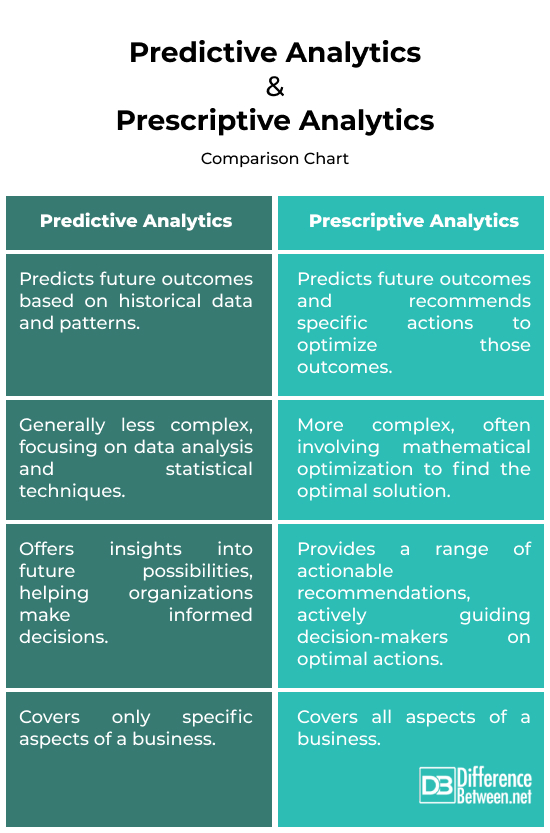Difference Between Predictive Analytics and Prescriptive Analytics
Business analytics has gained immense popularity faster than any management trends in recent history. In fact, analytics is considered as one of the top business trends of the decade. However, within the analytics ecosystem, almost every provider has their own definition of business analytics – each focusing on some combination of hardware and/or software capabilities.
Generally, analytics can be defined using three progressive phases: descriptive analytics, predictive analytics, and prescriptive analytics. In this article, we will talk about the difference between predictive analytics and prescriptive analytics.

What is Predictive Analytics?
Predictive analytics is like a crystal ball for data that uses big data to foresee our future moves and make predictions about our likely actions. It’s the process of crunching numbers and spotting patterns to forecast future events. It’s like making educated guesses about what might happen next by analyzing patterns in data.
Think weather forecasts but for things like sales trends or health outcomes. It blends math magic with real-world insight, helping us make smarter decisions. Hypothetically, a predictive analytics model will probably know when you’re asleep and can predict at what time you’ll wake up.

What is Prescriptive Analytics?
Prescriptive analytics takes this one step further by using advanced processes and tools to analyze data and content. It’s the most advanced stage of data analytics. It not only predicts future outcomes, like predictive analytics, but also suggests the best course of action to optimize those outcomes.
Marketing professionals, for example, can use prescriptive analytics to optimize their marketing campaigns. It can suggest the most effective marketing channels, messaging, and timing to maximize campaign ROI.
Prescriptive analytics leverages data, mathematical algorithms, machine learning, and business rules to recommend decision options. It takes into account various constraints, objectives, and potential outcomes to provide decision-makers with a range of strategies or actions to choose from.
Difference between predictive and prescriptive analytics
Use of data
– Predictive analytics uses and analyzes past data to predict potential future outcomes. It relies on historical data and statistical models to make predictions. It looks at past patterns and uses them to predict future trends, but it doesn’t provide specific recommendations.
Prescriptive analytics, on the other hand, suggests the best course of action and makes specific recommendations based on those forecasts. It not only analyzes historical data but also takes into consideration different scenarios and constraints. It factors in variables like costs, resources, and objectives to recommend the best course of action.
Nature of insights
– Predictive analytics predicts what is most likely to occur in the future based on historical data and patterns. It offers insights into potential future scenarios, such as sales forecasts or customer behavior, guiding businesses to prepare for what might happen.
Now, prescriptive analytics intelligently recommends specific actions to optimize those outcomes. It tells you what you should do to achieve the best results, making it a step beyond mere predictions.
Decision support and complexity
– Predictive models are generally less complex than prescriptive models. They focus on data analysis and statistical techniques to make predictions but do not involve extensive optimization algorithms. They provide decision support by offering insights into future possibilities. They help organizations make informed decisions but do not prescribe specific actions.
Prescriptive models are typically more complex because they consider multiple variables, constraints, and objectives. They actively support decision-making by offering a range of actionable recommendations. They provide guidance on what actions to take to achieve the best results, considering various scenarios and constraints.
Applications
– Predictive analytics finds use in various domains, including marketing, finance, retail, banking, insurance, energy, telecommunications, healthcare, and more.
Prescriptive analytics is employed in complex decision-making scenarios where multiple variables and outcomes are involved. It’s used in fields like supply chain optimization, healthcare treatment plans, financial portfolio management, etc.
Predictive Analytics vs. Prescriptive Analytics: Comparison Chart

Summary
To sum it up, predictive analytics looks ahead and tells you what might happen. Prescriptive analytics, on the other hand, not only predicts the future but also offers options and solutions for what you can do about it. Simply put, predictive analytics lays the groundwork with raw data. Prescriptive analytics takes that data and dives deeper, doing the heavy lifting to provide detailed analysis and recommendations.
FAQs
What are the key differences between predictive analytics and prescriptive analytics and how can they be applied in the context of financial decision-making?
Predictive analytics forecasts future financial trends based on data. Prescriptive analytics not only predicts but also recommends actions to optimize financial outcomes.
In finance, predictive analytics helps in forecasting market trends. Prescriptive analytics goes further, suggesting investment strategies or risk management actions to maximize profits or minimize losses.
What is an example of prescriptive analytics?
One prime example of prescriptive analytics is in the healthcare sector. Imagine a system that not only predicts a patient’s risk of developing a particular disease based on their medical history but also prescribes a personalized treatment plan to optimize their health outcomes. This goes beyond prediction and actively guides healthcare decisions for better patient care.
- Difference Between Caucus and Primary - June 18, 2024
- Difference Between PPO and POS - May 30, 2024
- Difference Between RFID and NFC - May 28, 2024
Search DifferenceBetween.net :
Leave a Response
References :
[0]Delen, Dursun. Prescriptive Analytics: The Final Frontier for Evidence-Based Management and Optimal Decision Making. FT Press, 2019.
[1]Bari, Anasse, et al. Predictive Analytics For Dummies. John Wiley & Sons, 2016.
[2]Big Data: Concepts, Methodologies, Tools, and Applications: Concepts, Methodologies, Tools, and Applications. IGI Global, 2016.
[3]Image credit: https://www.canva.com/photos/MADpYwE2nVc-predictive-analytics-graph-on-laptop/
[4]Image credit: https://www.canva.com/photos/MAEOH5SodCI-kpi-dashboard-predictive-data-analytics/
